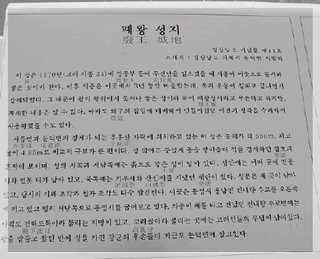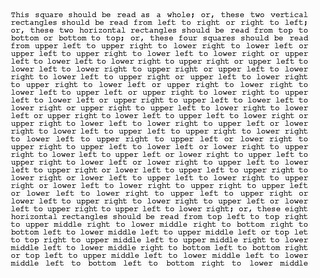Bravobo
Monday, June 26, 2006
Saturday, June 24, 2006
The arts of Zen are not intended for utilitarian purposes, or for purely
aesthetic enjoyment, but are meant to train the mind, indeed, to bring
ti into to contact with ultimate reality.
-Suzuki
Come said the muse,
Sing me a song no poet yet has chanted,
Sing me the universal.
In this broad earth of ours,
Amid the measureless grossness and the slag,
Enclosed and safe within its central heart,
Nestles the seed perfection.
-Walt Whitman
Thursday, June 22, 2006
See, you Later..
don't you know than I'm always waiting you
beneath the bark of the white ash tree
can't you hear the beat of my heart
I, Daphne, uncapturable..
see, you Later,
se you later..
Devil's dictionary
price:본래의 가치에 값을 매길때 양심의 상실에 걸맞게 적당한 액수를 보탠것
admiration: 타인이 자기와 닮은 점을 예의 바르게 인정하는 것
adage: 이빨이 약한 자도 씹을 수 있도록 뼈를 발라낸 인생의 지혜
pLan:우연한 결과를 달성하기 의해 최선의 방법을 놓고 애태우다
education: 자기 이해력에 한계가 있다는 것을 현자에게는 열어 보이고 우자에게는 닫아 보이는 것
eccentricity:별로 비용 안 들고 유명해 지는 방법
opportunity: 실망을 잡으려면 이것이 찬스
outdo:적을 만들다
otherwise:결국 마찬가지로
abuse:이쪽에서 반박을 할 수 없게 만드는 재주
befriend: 배은 망덕의 무리를 양성하다
bore: 이쪽의 이야기를 좀 들어줬으면 싶을 때에 저 혼자만 멋대로 지껄이는 자
foolhardy: 용기있는 짓을 한 것까지는 좋지만 재수가 없는
ignoramus: 당신을 잘 알고 잇는 모종의 지식에 대해서는 어두운 반면, 당신이 전혀 모르는 다른 종류의 지식에는 밝은 사람
learning: 학문에 정진하는 자에게 특유한 일종의 무지
accuse: 남의 비행을 책하거나 무가치하다고 단정하다.
asperse: 자신에게는 그것을 범할만한 유혹도 기회도 없덨던 악덕행위를 남이 하고 있다고 심술궃게 말하다.
critic: 아무도 자신의 비위를 맞추는 사람이 없기 때문에 자신이야 말로 아첨에 넘어가지 않는 사람이라고 자부하는 자
dictionary: 언어의 자유로운 성장을 억제하여 그 언어를 탄력성 없는 것으로 고정시키고자 생각해낸 문필에 관한 악랄한 조작.
consult: 이미 자기 스스로는 결심한 방침에 대하여 타인의 ㄷㅇ의를 구하다
hurry: 서투른 일꾼의 벼락치기 일
rumor: 인간이 애용하는 남의 명성을 말살하는 무기
history: 대체로 악인인 지배자와 바보스런 군대에 의해 야기되는 대체로 대단치 않은 사건에 관한 사실과 다른 기록.
polite: 알면서도 모르는 척하는 재주와 훈련을 쌓은
friendship: 날씨 좋을 때는 두 사람이 충분히 탈 수 있으나, 날씨가 나쁠 때는 오직 한 사람밖에 탈수 없는 크기의 배
consolation: 자기보다 유능한 자가 실은 자기보다 오히려 블행하다는 것을 아는것
selfish: 남의 이기에 대한 배려가 결여되어 있는
diary: 자기 생활 가운데 자신에 대해 얼굴을 붉히지 않고도 말할 수 있는 부분을 기록한 것
religion: 희망과 공포를 부모로 삼고 무지에게 불가지한 본질을 설명해 주는 딸
prescription: 호나자에게는 되도록 장해가 없도록 유의하면서, 현재의 상태를 최대한으로 연장하려면 무슨 조치가 가장 적절한가에 대하여 의사가 행하는 추측.
phiosophy: 시작도 없고 목적지도 없는 수많은 길로 이루어진 하나의 루트
erudition: 속이 텅 빈 두대골 속에 털어 넣은 책의 먼지
recollect: 종전에는 있지도 않았던 것까지 덧붙여서 생각해내다.
-Ambrose Gwinnett Bierce, The Devil's Dictionary
진실은 항상 아주 가까이에 있다.
단지 그것은 아주 교묘하게 가려져 있기 때문에 보이지 않는 것뿐이다.
우리들은 항상 진실을, 눈앞처럼 가까이에 두고도 그것을 파악하지 못하는 우를 범하곤 한다.
그렇다면 도대체 우리들은 무엇을 보고 있는 걸까?
우선, 당신이 보는것이 진실이라고 믿는가?
반은 정답이고, 반은 아니다.
왜냐하면, 진실이라는 것에는 뚜렷한 정의가 없기 때문이다.
예를 들어, 당신이 A라는 인물이 B라는 인물을 구타하는 장면을 봤다고 치자.
하지만, 당신은 그것이 소매치기인 B가 어떤 할머니의 지갑을 훔쳐가서 그것을 되찾느라 그렇게 했는지,
아니면 평소 건달이었던 A가 습관적으로 또 지나가는 행인인 B를 구타하는 것인지 알수가 없다.
왜냐하면 당신은 그 장면만을 보았기 때문이다.
그런고로, 당신이 알수 잇는 것은, 그저 A가 B를 구타하고 있다는 단편적인 사실 뿐이다.
이것은 객관성과 주관성과의 면과도 연결되는 이야기 이다.
만약 도마 안중근 선생의 기사가 있다고 치자.
객관적으로만 기사를 써서 그 사건을 보도하고자 한다면, 안중근 선생은 그저 못된 폭탄테러범이며, 일본을 싫어하는
극단적인 국수주의자로 비춰질지도 모른다.
그러나 만약 주관성을 가미하여 이 기사를 보도한다면, 이야기는 상당히 달라지고 만다.
그는 영웅이 되어버린다.
한국을 통째로 집어삼키려고 했던 일본의 관리를 저격하려고 시도했던 용감한 한국인이 되어버린다.
그것은 그 주관적인 기사가 앞 뒤 내용을 전부 포과할고 있기 때문이다.
(물론 그 주관적인 기사도 완전히 진실에 가깝다고 할 수는 없지만, 그것은 객관적인 기사와 주관적인 기사 중에서 그나마
주관적인 기사가 더 진실에 가깝다는 소리이기 때문에, 이 논점에서는 그닥 문제가 되지 않는다.)
어찌되었건, 자신이 보고 있는 것이 완벽한 진실이 아니라는 기분이 좋을 인간은 없기 때문에.
우리는 그냥 다 그러려니 하고 넘어간다.
이것저것 건드리다 보면 머리가 아픈 법이다.
단 하나의 실을 가지고도 오만가지 편견과 오해가 존재하는 법인데, 엄청난 양의 정보가 넘쳐나는 우리 세상은 하물며 어떨ㄱ까.
따라서 그냥 모두들 알고도 그려너니 하고 무시하고 지나가는 것이다.
물론 그것을 정확하게 관념적으로 이해해 내는 이는 그다지 많지 않으나,
보통 인간이라면, 대략 이러면 이런가 보지, 하고 알게 모르게 그것을 실생활에서 발견하고 수긍해 내는 것이다.
진실은 있다.
단지 그것은 뚜렷하게 잡히는 성질의 것이 아니기 때문에, 그것을 온전히 볼 수 없을 뿐이다.
그저 그럴 뿐이다.
Tuesday, June 20, 2006
Dennis ophenheim
Oppenheim remarked, "machines are a rather perfect device to use as a metaphor for thinking. [Through these] industrial and mechanical systems. . . I felt I could objectify the mechanics of thought." Mining ore, for example, suggests coming up with an idea. Diamond cutting suggests the refinement of a thought-object. A launching structure suggests the moment of putting a thought into action, and so on. -p.39
Something similar was occuring at this time in his close friend Acconci;s work also. For both Oppenheim and Acconci the era of directly embodying theory through the use of mental process or consciousness as material had passed, and questions concerning the nature of the physical art object and its representational force had reasserted themselves. pp.39
Thursday, June 15, 2006
Unformed Landscape, Peter Stamm
On Sunday the pastor spoke of the water of life that poured out into the sea of eternity. Then, he said, every creature living there will swim freely. there willbe quantities of fish. Because as soon as this water comes, the salt water will heal, and everything the river touches will remain alive forever. -p.3
Thomas knew what he was after. When he started talking about marriage, it hadn't even crossed Kathrine's mind. His life represented a bold stroke through the unformed landscape of her life. Like the pistes for a snowmobile, marked with poles in the snow, his life cut across hers, with an objective and a destination. It was possible that Thomas himself didn't know why he had chosen this particular path, but he had put down the marker poles, and it was a way that could be gone, and that he was going to go with her. p.19-20
All the things he had told her. And what had she ever told him? He had never asked about anything in her life, and if she did happen to talk about it, he hadn't paid any attention. So she had ended up keeping her stories to herself. Her stories. p.45
What was done was done. That was what her father had always said to her mother, what's done is done. When he had to sell his boat, either because the fishing grounds were almost fished out, or the price of fish was going down, or because he was ill or not a good fish man, who could say. When he went to work in the fish factory, not difficult work, but he was already sick. And when Kathrine went to visit him in the factory, she was about fourteen, and asked him, isn't it boring to do the same thign all day long, he would say what's done is done. As if it didn't matter that he had once owned a boat. But it wasn't true. In the village, nothing was ever done. p.47
She thought of the fish moving in the depths, through the calm water, in darkness, suddenly being plucked up to the surface in a net, into the storm. Thousands of fish, squirming fish, pulled up onto the deck of the ship, an enormous body of fish, tipped into the hold, where they continued to wriggle and finally suffocated, or were killed by the fishermen. Katherine thought of the tuna fish in Boulogne, with their old, earnest faces that looked almost human. She thought of how people died. Whether you continued to try and swim. The brief moment when you went down, before you suffocated. When you stopped struggling for breath, stopped thrashing about with your arms. The instant in which he'd given up, and maybe swam a couple more strokes, not to get to the surface, there was no point, and he knew it. A couple of strokes. And the calm, the quiet under the water. The fact that the last moment is supposed to be happy. p.128-129
Wednesday, June 14, 2006
gunther Uecker
In 1957 he embarked on a series of 'nail reliefs', since he considered the two dimensional lines in drawings to be lifeless. Nails gave him the opportunity to make three-dimensional lines. He went on to try making the 'lines' of the nails part of the actual space by shooting arrows on a canvas. The monotonous ritualistic repetition of hammering nails was a form of therapy for Uecker, of which the shootingof arrows was a part. -p.163
Gunther Uecker


The act of driving a nail is monotonous, yet it has to be carried out with great care; Uecker, who had already become interested in Zen Buddhism at an early date, saw an activity in which a balance exited between its meditative qualities and its aggressive nature.The first nail objects arose in the late fifties. Initially, Uecker restricted himself to Punctuation and the creation of a Perforated Structure , as two works from 1957 and 1958 were called that featured nails, or, to be more precise, "the principle of the nail as a point, as a hole driven into the pictorial surface, or as a trace of a hole," as Wieland Schmied wrote on the occasion of an exhibition in the Kestner Society in Hanover. During the time that followed, Uecker refined his method. The protruding, projecting steel pin proved to be the ideal vehicle for his artistic purposes. "Where two lines touch," Uecker wrote, "is a point. That is where I drive a nail. The nail's shadow creates a new line - the movement of the shadow develops into a perception of time." Point, line, a shadow varying according to the light source and the resulting symbolic representation of the passage of time - these are the coordinates within which Uecker established his working method.
It's only after taking a closer look, however, that it becomes clear how deceptive the initial impression actually is - that the apparent "nature" actually derives from another, harder nature. While the contrasts dominate at a distance, seen from close up, the works produce an oscillation of perception between optical deception and the knowledge of a highly concrete, nearly banal objectivity. It almost seems as though the picture's effect were spreading into the room, determining it: "My attempt at activating a real space through creating structures, to enable that space to be experienced as a pure state of objective aesthetics, led me to pursue new formal means," Uecker stated in the early sixties. "I use nails as structural elements; I don't want them to be seen as nails. In using these means, I'm concerned in creating an oscillation in their ordered relationship to one another, one that disturbs their geometric order, is capable of unsettling it. The white objects are to be seen as a state of extreme intensity in continuous change, due to the fluctuation in light. I consider mutability to be important; it is able to convey the beauty of movement."
Gunther Uecker


Gunther Uecker, born in 1930, member of the artists' group ZERO and mastermind of the action on the banks of the river Rhine, demonstrated frequently throughout these years. Art and life, art and politics, art and ecstasy - it was all supposed to become one in the sixties and early seventies, and Uecker, brother-in-law of Yves Klein, the French happening artist who painted the brilliant blue canvases, was right in the middle of the scene. The movement wanted to achieve something new and was little impressed by bourgeois criteria.
Tuesday, June 13, 2006
zen in the fifties
Yves Klein is influenced by Zen, which emphasize the unity and harmony of mind and body, the experience of true reality, transcendence above words, enlightenment through silence, thought surpassing logic and an awareness of the power of nothing.
Judo had apparently taught him how to restore and control energy, how to breath and move, given him a feeling for balance, proportions and satial harmony, as well as providing him with ways in which to express himself and with certain psychological rituals. p.124
'Le vide', the empty space of the Iris Clert Gallery, which Klein presented as an exhibition in May 1958, is reminiscent of the emptiness in temples and gardens which is favoured in Zen. Klein's intention with this work was to arouse an awareness of sensitivity and immateriality. 'Theatre du vide', a project which Klein conducted in August 1960, of an artist plunging into space, is a 'falling action' which is similar to 'floating through air' which occurs during a Judo fight. 'Le saut dans le vide' (Leap into emptiness), as Klein entitled his project in 1961, is also a description used in Zen meditation, referring to the ultimate goal of Satori. p.126-127
폐왕성



폐왕성과 의종에 관하여
고려 18대왕인 의종이 정중부의 난으로 쫓겨나 유배를 왔던 곳이다. 인종의 맏아들이었고 제2비인 공예태후 임씨의 소생이었던 의종은 1146년 왕위에 올랐다. 처음에는 왕권강화에 힘썼으나 점차 방종하여 문신들과 어울려 연회를 베푸는 일이 잦아지면서 문신들을 우대하고 무신들을 홀대하여 정중부의 난을 일으키게 만들었다. 김보당에 의해 복위를 꿈꾸며 경주로 옮겨졌다가 결국 이의민에게 죽고 만다.
폐왕성은 길이 640미터 높이 8미터의 산성으로 유배왔던 의종이 머물렀던곳이며 거제시 둔덕면에는 여러 마을의 이름에 당시의 흔적들이 남아있다. 상둔과 하둔은 호위군의 주둔지로 넓은 들에 둔전을 설치하여 식량을 생산 공급하던 곳이었고 농막 마을은 농사를 짓는 곳, 마장과 시목은 말을 키우던 곳이라는 의미이다. 폐왕성이 있는 우두봉은 정상부위에 초원이 있는데 이 초원에 의종때부터 말을 방목하였다고 한다.
전쟁을 대비한 무기로 쓰기 위해 비축해 두었던 것일까? 바닷가에는 널려있지만 산위에서는 보기힘든 몽돌들이 무더기로 있는 곳이 있었고 누군가 그 몽돌을 바위위에 쌓아두었다. 왕위를 뺏기고 머나먼 유배의 땅에 새로 둥지를 틀었던 의종은 이곳에서 복위되기를 꿈꾸었을 것이고 그를 따라왔던 무리들은 의종과 더불어 다시 찬란한 햇살 아래 서기 위해서 얼마나 많은 노력을 했었을까? 세월에 묻혀서 의종은 이제 역사속의 인물로 남아있고 그가 한시절을 보냈던 성은 무성한 풀숲에서 주인을 잃은채 쓸쓸히 잠들어있다. 성을 뒤로하고 둔덕쪽으로 내려오며 뒤돌아서서 올려다 본 폐왕성. 견내량을 바라보며 서있는 폐왕성의 어디에선가는 복위를 꿈꾸다 떠났고 끝내 경주에서 세상을 하직했던 의종의 넋이 남아있을 듯 하다. 그리고 팔백년이 넘는 세월이 흐른 지금 그곳에서는 역사의 패자인 한 남자의 삶이 아주 일부분 조용히 사람들의 기억밖으로 사라지고 있었다.
zen in the fifties
Satori,which means "insight into the true meaning", is only possible to ontain by intensely felt and practical, personal experiences. The experience of concrete things from everyday life is particularly importany. p.12
Irrationality and paradoxical thought are the only tools with which to gain insight into the true existence, since being cannot be penetrated by cerebral means.
"Hard because to understand it, is not to understand it; easy because not to understand it, is to understand it" Suzuki said.
Once Satori has been obtained, the world is experienced from a new, fresh point of view, as well as in its "wholeness'. -p.12
Zen unites the religious and the secular. And that has consequences for the Zen arts. Not only are arts practised in traditional forms, like poetry and painting, but also, perferably, by way of everyday activities like writing, tea-making, flower arranging, self-defence, archery, and swordsmanship. The necessary component of these arts obviates the antithesis between mind and body. -p.13
Heinrich Dumoulin described the relationship between art and meditation as follows: "The Zen arts are inspired by meditation and the meditation experiences manifest themselves in the arts." Zen wants us to make ourselves free and untrammelled, and sees the practice of art as a way of attaining the awakening and liberation of the self.
Zen wants us to get in touch with the 'inner workings of our being', without seeking refuge in the 'self' or resorting to anything external or superadded. -p.13
Shin'ichi Hisamatsu formulated seven characteristics of 'Zen Aesthetics' in his book zen and the fine arts: Asymmetry, Simplicity, Naturalness, Tranquillity, Freedom of Attachment, Subtle Profundity and Austere Sublimity. -p.16
In addition to these characteristics, we might add that the figures are placed in the entire composition. That is partly due to the factthat the empty sapces in the paintings are just as important as the painted figures.
Suzuki descrives the style and technique of Sumi-e in this essays as follows:
" THe inspiration is to be transferred on to the paper in the quickest possible time. The lines are to be drawn as suiftly as possible and the fewest in number, only the absolutely necessary ones being indicated. No deliberation is allowed, no erasing, no repetition, no retouching, no remodelling". (..)The master lets his brush move "without his conscious efforts. If any logic or reflection comes between brush and paper, the whole effect is spoiled.(...) There is no chiaroscuro, no perspective in it. Indeed, they are not needed in Sumi-e, which makes no pretension to realism. It attempts to make the spirit of any object move on the paper. Thus each brush-stroke must beat with the pulsation of a living being. It must be living too (...) the rhythm of its living breath vibrates in them."
-p.16
Aspects of Zen and the Zen arts
1. Emptiness and nothingness
In the Zen belief the concepts of emptiness and nothingness do not refer to an absence of something, but are 'complete' in themselves. It means that empty is also full, and nothing is something. -p.17
Suzuki worded Sutra as follows:
"Thus, Sariputra, all things have the character of emptiness, they have no begining, no end, they are faultness and not faultness, they are not perfect and not imperfect. Therefore, O Sariputra, here in this emptiness there in no form, no perception, no name, no concepts, no knowledge. No eye, no ear, no nose, no tongue, no body, no mind. No form, no sound, no smell, no taste, no touch, no object. . . There is no knowledge, no ignorance, no destruction of ignorance..."
The great significance of emptiness and nothingness in Zen is reflected in the description of Mu(meaning emptiness and nothingness) as "pure experience, the very foundation of our being and thought" and "always with us and in us(...), is our life itself." p.19
Moreover, emptiness plays an important part in the Zen arts, as a formal aspect. Take, for example, the central role played by the large empty spaces in Sumi-e, like the favourite subject of Enso and the expanses of emptiness in Zen garden. -p.19-20
2. Dynamism
The world is seen as a dynamic and constantly changing whole.Suzuki said, "Life itself must be grasped in the midst of its flow; to stop it for examination and analysis is to kill it, leaving its cold corpse to be embraced". It may be one which is noly attained after a disciplined learning process, in which the unity of subject and object has to be attained. The ensuing spontaneity is then one of naure itself. In the end, results of the Zen Master's painting and writing, the spontaneously painted lines are primarily what give the work a dynamic experession. The empty parts emanate a 'quiet dynamism.' -p.20
3. Indefinite and surrounding space
The japanese word Ma means both time and space, and is mainly interpreted as 'interval'. This term is not only used for a time interval, as in the pause between two notes of music, but the space between two brush-strokes is also experienced as Ma.
The traditional Japanese artist also see space as 'surrounding', meaning that during his work he is aware of the space around him, not just in front of him(similiar with Western persepective which aware of the space in front of him, and envisages it as receding.)
Kitaro Nishida described the space as "the space in art from the Far East is not the space facing the self, but the space in which the self is situated." ( the difference: observation with respect to Western artists, and participation with respect to Eastern artists)
In sumi-e the experience of the surrounding space can be perceived in the suggestion of an indefinite space. That means that there is not by any means a clearly receding space, but that the space in the work is also part of the space in which the viewer is situated. The absence of a horizon means that the suggestion of space can also be interpreted as an infinite space. p.20
4. Direct experience of here and now
Suzuki stresses thre focus on the concrete things of everyday life, commenting that Zen attaches inexperessibly great significance even in holding up a finger or in saying a 'good morning' to a friend casually met in the street. Shin'ichi Hisamatsu relates the interest within Zen in the commonplace with the amis of art:
"When in the raising of a hand or in a single step something of Zen is present, that Zen content seems to me to possess a very specific, artistic quality. A narrow conception of art might not accept that such manifestations contain anything artistic, but to me it seems that they possess an artistic quality that ordinarily cannot be seen, In fact, in such vital workings of Zen, I believe that something not merely artistic but also beyond art is involved, something toward which art should aim as its goal."
Suzuki thinks every Zensist is an artist, as he makes a work of art of his life. -p.22
5. Nondualism and the Universal
zen prefers nondualism, which is the opposite to the traditional Western way of thinking, based on 'discrimination'. This means that Western Man is primarily oriented towards edtablishing his own identity and that of other people and things, doing so by seeking differences. Zen advises a unification of antitheses.
The Zen Master tries to feel ar one with his materials, and thus obtain a more universal expression. The resulting pieces should also characterize a nondualism. That means that a fragment can seem both full and empty, that dynamism is at the same time rest, form can also be formless, and so on.-p.22-23
Monday, June 05, 2006
Liquidation
Why am I recording all this? I don't know, because none of it goes to show a thing. In the world as it presented itself to me, effects did not always derive from causes, nor did causes always prove adequately grounded points of departure; as a result, in that world the sort of logic that presumed to arrive at causes through unraveling the effects was a mistaken logic. I consider that the world as it presented itself to me had no logic whatsoever.
-p.36-37
내가 죽는 방법을 생각하는 것은 죽기 위해서가 아니라 살기 위해서다. - A. 말로
모든 희망은 인간에게 허락되어 있다. 세상에서 사라져 버리겠다는 희망까지도. -장 로스탕
사람으로 한 번 태어났으니, 목숨을 해치지 말고 목숨이 다할 때까지 살아야 한다. -장자
삶이 고단하고 힘들다고 죽으려 하지 말라. 어깨에 진 짐이야말로 인간의 목표를 달성시키는데 도움이 될 것이다. 짐을 벗어버리는 유일한 길은 목표를 달성시킨다고 생각하며 살아가는 것이다. -에머슨
쇼펜하우어의 3대 행복론. 첫째, 사람은 나지 않음이 행복하다. 둘째, 태어났으면 일찍 죽는 것이 행복하다. 셋째, 일찍 죽지 않았으면 자살하라. (그는 염세주의의 대표자로, 1988년에 태어나 1860년까지 오래 살았으며(72세), 1831년에는 당시 유행한 콜레라를 피해서 프랑크푸르트암마인으로 옮겨가 평생을 그곳에서 살았다)
시간을 죽이는 것은 점차적으로 자살하는 것이다. -불케
인간은 자연사(自然死)하는 것이 아니라, 자살하는 것이다. -세네카
자살하고 싶은 생각은 크나큰 위로이다. 그것으로 인해 헤아릴 수 없이 많은 끔찍한 밤을 성공적으로 보내는 것이다. -프리드리히 빌헬름 니체
자살할 힘을 가진 사람은 행복하다. - A. 테니슨 [티소나스]
죽고 싶은 생각이 들면 일을 하라. -볼테르(사상가)
참으로 위대한 철학의 문제는 하나밖에 없다. 그것은 자살이다. 인생을 괴로워하며 살 값어치가 있는지 없는지의 판단을 하는 것, 이것이 철학의 기본적인 문제에 대답하는 것이다. - A. 카뮈 [시지프스의 신화]
자살한다는 것은 어떤 의미에서는 멜로 드라마에서 볼 수 있는 것처럼 일종의 고백하는 것이라 하겠다. 그것은 인생에 패배했다는 것, 혹은 인생을 이해하지 못했다는 것을 고백하는 것이다. - A. 카뮈 [시지푸스의 신화]


















